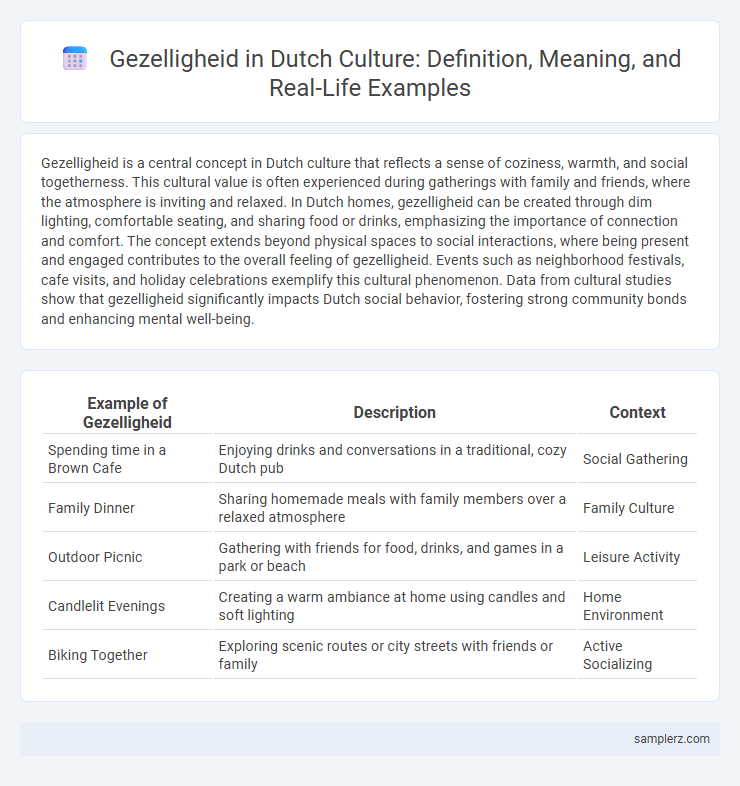Gezelligheid is a central concept in Dutch culture that reflects a sense of coziness, warmth, and social togetherness. This cultural value is often experienced during gatherings with family and friends, where the atmosphere is inviting and relaxed. In Dutch homes, gezelligheid can be created through dim lighting, comfortable seating, and sharing food or drinks, emphasizing the importance of connection and comfort. The concept extends beyond physical spaces to social interactions, where being present and engaged contributes to the overall feeling of gezelligheid. Events such as neighborhood festivals, cafe visits, and holiday celebrations exemplify this cultural phenomenon. Data from cultural studies show that gezelligheid significantly impacts Dutch social behavior, fostering strong community bonds and enhancing mental well-being.
Table of Comparison
| Example of Gezelligheid | Description | Context |
|---|---|---|
| Spending time in a Brown Cafe | Enjoying drinks and conversations in a traditional, cozy Dutch pub | Social Gathering |
| Family Dinner | Sharing homemade meals with family members over a relaxed atmosphere | Family Culture |
| Outdoor Picnic | Gathering with friends for food, drinks, and games in a park or beach | Leisure Activity |
| Candlelit Evenings | Creating a warm ambiance at home using candles and soft lighting | Home Environment |
| Biking Together | Exploring scenic routes or city streets with friends or family | Active Socializing |
Defining Gezelligheid: The Heart of Dutch Culture
Gezelligheid, a foundational concept in Dutch culture, embodies a sense of cozy togetherness, warmth, and belonging that transcends physical settings. This feeling is often experienced during intimate gatherings with family and friends, where the atmosphere fosters comfort and genuine connection. Its significance in daily life reflects the Dutch value placed on social harmony, making gezelligheid a defining cultural phenomenon.
Historical Roots of Gezelligheid in the Netherlands
Gezelligheid, a core aspect of Dutch culture, traces its historical roots to communal gatherings in traditional village settings where social warmth and togetherness were essential for survival during harsh winters. Rooted in the Middle Ages, this concept evolved from collective activities like shared meals and folk festivities, reinforcing strong community bonds. Over centuries, gezelligheid has embodied an atmosphere of coziness, conviviality, and belonging uniquely integral to the Netherlands' social fabric.
Gezelligheid at Home: Family Gatherings and Traditions
Gezelligheid in Dutch culture is vividly exemplified through family gatherings and traditions at home, where warmth, togetherness, and comfort create a uniquely cozy atmosphere. These moments often involve shared meals, storytelling, and traditional celebrations like Sinterklaas, fostering deep social bonds. The emphasis on creating an inviting environment highlights the cultural value placed on connection and well-being within the domestic sphere.
Cozy Cafés and Pubs: Public Spaces of Gezelligheid
Cozy cafes and pubs in Dutch culture epitomize gezelligheid, offering warm atmospheres where friends and strangers connect over traditional Dutch beverages like jenever and locally brewed beers. These public spaces feature intimate wooden interiors, soft lighting, and communal seating that fosters conversation and relaxation, reflecting the cultural value of togetherness. Regular events such as live music and quiz nights enhance the inviting ambiance, making these venues central to social life in the Netherlands.
Celebrating Sinterklaas: A Gezelligheid Holiday Tradition
Celebrating Sinterklaas in Dutch culture exemplifies gezelligheid through intimate family gatherings, exchanging thoughtfully wrapped gifts, and sharing traditional treats like pepernoten and chocolate letters. The festive atmosphere is enhanced by singing Sinterklaas songs and the warm presence of the Sinterklaas figure, fostering connection and togetherness. This beloved holiday tradition highlights the Dutch emphasis on conviviality, comfort, and the joy of shared experiences.
Markets, Festivals, and Community Events
Gezelligheid in Dutch culture shines through vibrant local markets where neighbors and tourists gather to enjoy fresh produce and lively conversations, fostering a warm community atmosphere. Festivals such as King's Day transform streets into colorful celebrations filled with music, dancing, and shared joy, embodying the essence of togetherness. Community events, including neighborhood potlucks and open-air concerts, emphasize social bonding and create inclusive spaces that highlight the Dutch value of gezelligheid.
Interior Design: Creating a Gezellig Home
In Dutch culture, gezelligheid is exemplified through interior design by incorporating warm lighting, natural materials, and cozy textiles to create an inviting atmosphere. Elements such as soft cushions, wooden furniture, and candles enhance the sense of comfort and togetherness essential to a gezellig home. The integration of personal touches and communal spaces fosters social interaction and emotional well-being.
Gezelligheid in Dutch Work Culture
Gezelligheid in Dutch work culture fosters a sense of camaraderie and warmth among colleagues, emphasizing social connection beyond mere productivity. This atmosphere is cultivated through regular informal gatherings, shared breaks, and open office layouts that encourage interaction. Prioritizing gezelligheid enhances teamwork, reduces stress, and strengthens workplace morale in Dutch organizations.
Seasonal Examples: Gezelligheid in Winter vs. Summer
Gezelligheid in Dutch culture shines through cozy winter scenes of dimly lit cafes, warm candlelight, and shared steamy cups of hot chocolate during long, cold evenings. In contrast, summer gezelligheid bursts outdoors with vibrant street markets, lively picnics by canals, and relaxed gatherings under the bright sun, celebrating warmth and togetherness. Seasonal shifts highlight Dutch adaptability in creating intimate, social atmospheres that define the essence of gezelligheid year-round.
Gezelligheid and Friendship: Social Bonds in Dutch Life
Gezelligheid in Dutch culture epitomizes warmth and conviviality, creating a unique atmosphere that strengthens friendships through shared experiences and intimate gatherings. This cultural concept fosters social bonds by emphasizing togetherness, relaxation, and genuine connection, essential elements in Dutch social life. Celebrations, casual coffee breaks, and cozy evenings in homes exemplify how gezelligheid nurtures deep, lasting friendships in the Netherlands.

example of gezelligheid in Dutch culture Infographic
 samplerz.com
samplerz.com